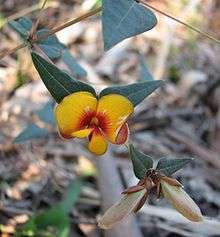Platylobium obtusangulum
Platylobium obtusangulum, the common flat-pea, is a shrub that is endemic to Australia. It is a member of the family Fabaceae and of the genus Platylobium.
| Common flat-pea | |
|---|---|
 | |
| Scientific classification | |
| Kingdom: | |
| (unranked): | |
| (unranked): | |
| (unranked): | |
| Order: | |
| Family: | |
| Subfamily: | |
| (unranked): | |
| Genus: | |
| Species: | P. obtusangulum |
| Binomial name | |
| Platylobium obtusangulum | |
| Synonyms | |
|
Platylobium macrocalyx Meisn. | |
The species is an erect or straggling shrub that can grow up to 1 metre in height. The leaves are variable in shape and their length ranges from 1 to 3 cm.[1]
The flowers appear in spring. These are yellow with a red centre and are supported by short pedicels that are concealed by a series of overlapping bracts. The pods which follow are 14 to 25 mm in length and 10 to 14 mm in width.[1]
The species was first formally described by botanist William Jackson Hooker in 1833 in Botanical Magazine[2]
This species is found in South Australia, Tasmania, and Victoria.
References
- Corrick, M.G. & Fuhrer, B.A. (2001). Wildflowers of Victoria and adjoining areas. Australia: Bloomings Books. ISBN 978-1876473143.
- "Platylobium obtusangulum". Australian Plant Name Index (APNI), IBIS database. Centre for Plant Biodiversity Research, Australian Government, Canberra. Retrieved 2 May 2012.